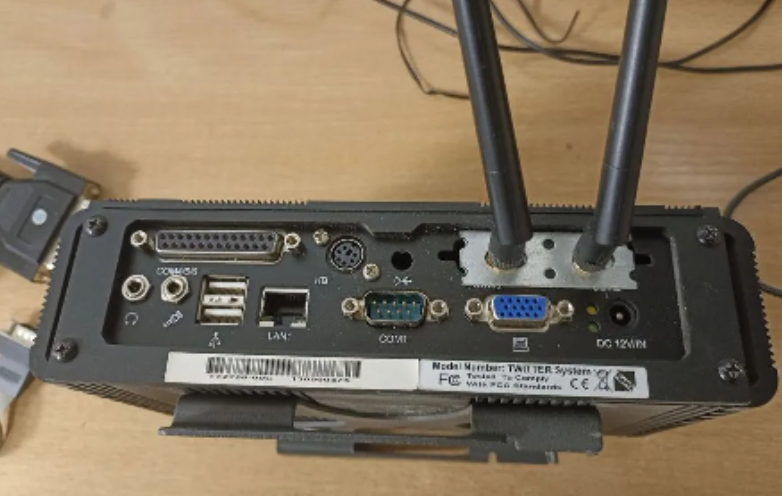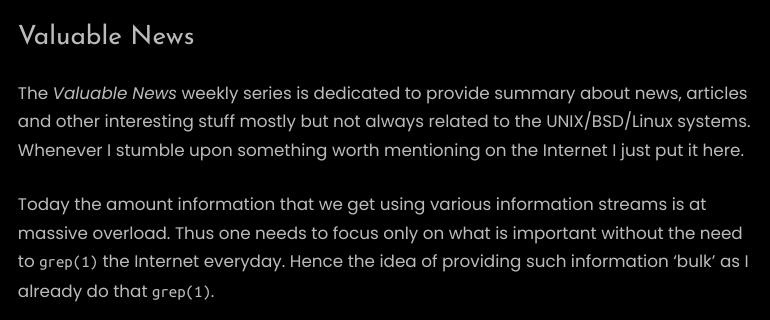Search results for tag #netbsd
https://www.defert.com/musCAT.mp4
Of course, it runs NetBSD!
Credit: u/1r0n_m6n <https://www.reddit.com/r/NetBSD/comments/1msm1qs/of_course_it_runs_netbsd/> via @jaypatelani in Matrix
 boosted
boostedReding the docs for setting up NetBSD on my Raspberry Pi 2
https://wiki.netbsd.org/ports/evbarm/raspberry_pi/
 boosted
boostedI need to update my #netbsd "wine in a 32-bit chroot" guide, a few things have changed... I didn't need to set WINEDLLPATH in the past.
 boosted
boostedIn a moment of Friday night weakness I may have bought an old X230 ThinkPad for my #NetBSD low-distraction writing machine :’).
Didn’t pay the extra for express shipping, so hopefully it comes in a week or so!
はてなブログに投稿しました
NetBSD/amd64,i386 10.1 ておくれLive Image 20250815版 - tsutsuiの作業記録置き場 https://tsutsui.hatenablog.com/entry/teokure20250815
#はてなブログ #NetBSD #pkgsrc #mikutter
All of those things are absolutely wonderful and make many of todays software developers look ... spoiled? What I want, however - and what I love doing - is making this old hardware do stuff its makers never dreamt of, things that are as far removed from their time as possible. That's why I will, if #NetBSD permits, run bleeding edge BSD on a 286-on-486steroids, and why I run web+ftp+irc servers (yes, multitaskign) on one 286 and multiple BBS nodes on a 386 - like one used to do, of course.
I cannot state often enough how amazing it is that there's still software developed today that will work under such constraints.
 boosted
boostedIf anyone would like to help me test my portable email server, please send something to greetings@zia.io
#NetBSD #mailserver
I just installed a new battery on my test email server. Unlike the battery that’s close to absolute zero, the battery for my email server progressively lost capacity until it got to the point where it wouldn’t charge.
 boosted
boostedOk, so it looks like this toot blew up.
And what can I say? If you liked it, I by all means encourage you to try #NetBSD out for yourself! If you've had enough experience in a Unix command-line, and isn't afraid to do some reading on the documentation, it's a very rewarding experience.
You can see how I ran NetBSD on the first Raspberry Pi (2012 Model B) in this post for the Old Computer Challenge. If *that* was usable, anything else is going to be great!
https://kzimmermann.0x.no/articles/old_computer_challenge_2025.html
Happy hacking!
A new #blog post appears!
I discovered that the GNU D compiler has been broken on FreeBSD 14 for over a year and it seems no one noticed. Let's discover the issue and brainstorm some solutions to it.
A great case study for why operating system package maintainers matter.
https://briancallahan.net/blog/20250813.html
#dlang #dlanguage #freebsd #bsd #openbsd #netbsd #dragonflybsd #unix #gcc #gdc #gnu #compiler #compilers #d #linux #opensource #freesoftware
 boosted
boostedFound a good fanless, completely quiet PC with a LAN, WiFi, 2 COM ports, LPT, VGA and SSD inside — all that for the price of two good meals 

It has 1 Gb RAM and Intel Atom N270 1.6 GHz (i686, 32-bit). So I have a question to #NetBSD folks — how well NetBSD supports 32-bit architectures?
I want to do some #selfhosting, so I need to install some things: sshd, rsyncd, lighweight HTTP server (nginx?), syncthing, ejabberd, some mail server, etc  Any chances that these software still builded for i686 and exists in NetBSD repos?
Any chances that these software still builded for i686 and exists in NetBSD repos?
Hello to our friends in Singapore 🇸🇬!
We’re happy to announce that we just opened up a new POP in Sng1, SN to come even closer to you! What does it mean?! IP-Space in Singapore including GEO objects & lower latencies in your area 🥳
Thanks to Route64 and @gyptazy !
#RUNBSD #FreeBSD #OpenBSD #NetBSD #BSD #BSDHosting #Hosting #VM #VPS #IPv6 #BGP #Singapore #BoxyBSD
I think the "Kids in the Hall" character "Hecubus" would make a far better mascot, than the current "devil horns" mascot which some of the BSD distros use. Do you agree? See reply for image of Hecubus. #BSD #OpenBSD #NetBSD #OpenSource
| Yes: | 0 |
| No: | 0 |
No really, I’ve spent the last few days in idle time looking at second-hand ThinkPads.
I’m thinking of getting an older X series or Carbon and putting #NetBSD on it as a lower distraction writing tool.
I have no option but to once again going to praise the #NetBSD on an amazing operating system.
Since I installed it on the Pi 4, the experience has been so smooth that I don't even realize I'm using a supposedly "cheap and underpowered computer" as it was the case with previous OSes. Nope, not anymore.
Instead, there are packages for everything, my architecture is treated as first-class, the performance is always high, and the more I learn about how to use it, the better my experience becomes. No other Linux or BSD met all of these points.
And to top it off? Booting up takes no more than 15-20 seconds. It's less than in my mom's Macbook Pro running Linux Mint!
Again, I can't *not* praise the NetBSD team enough for such achievements. Thank you so much for your hard work that clearly shows that you dogfood your development!
Latest 𝗩𝗮𝗹𝘂𝗮𝗯𝗹𝗲 𝗡𝗲𝘄𝘀 - 𝟮𝟬𝟮𝟱/𝟬𝟴/𝟭𝟭 (Valuable News - 2025/08/11) available.
https://vermaden.wordpress.com/2025/08/11/valuable-news-2025-08-11/
Past releases: https://vermaden.wordpress.com/news/
#verblog #vernews #news #bsd #freebsd #openbsd #netbsd #linux #unix #zfs #opnsense #ghostbsd #solaris #vermadenday
Latest 𝗩𝗮𝗹𝘂𝗮𝗯𝗹𝗲 𝗡𝗲𝘄𝘀 - 𝟮𝟬𝟮𝟱/𝟬𝟴/𝟭𝟭 (Valuable News - 2025/08/11) available.
https://vermaden.wordpress.com/2025/08/11/valuable-news-2025-08-11/
Past releases: https://vermaden.wordpress.com/news/
#verblog #vernews #news #bsd #freebsd #openbsd #netbsd #linux #unix #zfs #opnsense #ghostbsd #solaris #vermadenday
#virtualisation avec #NetBSD et #NVMM, épisode 11, tout de suite sur https://twitch.tv/ahp_nils ! #sysadmin #devops #twitchfr #twitchstreamer #TwitchStreamers #BSD #qemu
Server management is best done over serial. For contemporary x86, I just install some kind of Pi which can be accessed via IPv6. It provides a serial console and the ability to do a hardware reset of the x86 system. There's no sense in having a dedicated BMC that's too fragile to put on the Internet on its own, or paying for the datacenter to provide OOB connections to those fragile BMCs.
Perhaps I'll change my mind when I can run #NetBSD on common (Aspeed) BMCs.
@justine What’s in my homelab? Hmmm…
The main NAT router / IPv6 router / firewall / DNS / DHCP / stratum 1 time server is a 2014 era AMD Athlon. Way back Fry’s Electronics was selling AM1 motherboards with quad core 2 GHz Athons, heat sinks and fans for something like $45. I bought quite a few. They’re reasonbly fast, tiny (mini-ITX), take very little power, and can take 32 gigs of memory.
My distcc / VM / qemu / NFS / sequence alignment system is a Ryzen 5900X with 64 gigs.
Building #NetBSD #pkgsrc binary packages are:
- Dual 1 GHz AlphaServer DS25 with 12 gigs of memory and mirrored SSDs compiling Alpha packages
- Original Raspberry Pi and RPi Zero compiling earmv4 packages
- Plextor PX-EH25L compiling sh3el packages
- VAXstation 4000/60 compiling VAX packages
- Pine Rock64 compiling aarch64eb packages
- Raspberry Pi 4 with hardware mirrored USB enclosure which runs as NFS server for all the pkgsrc build machines.
Then, for m68k packages:
- 1U Quadra 605, 33 MHz ‘040
- Quadra 610 with CPU clock doubler, 50 MHz ‘040
- Quadra 630, 40 MHz ‘040
- Amiga 4000 with Cyberstorm Mk III, 66 MHz ‘060
I also have a Sun Fire V245 to compile sparc & sparc64 pkgsrc packages, but that takes more power than the AlphaServer and the Ryzen 5900X combined, so I only run that in the winter.
 boosted
boostedARM'd and dangerous: kzimmermann takes on the #OldComputerChallenge 2025 with nothing but a Raspberry Pi Model B.
https://kzimmermann.0x.no/articles/old_computer_challenge_2025.html
Yes, it's late - but it's done. Sorry for the delay, I was having too much fun learning #NetBSD, I guess :D
#oldcomputers #occ25 #runbsd #oldcomputerchallenge2025 #100DaysToOffload
$ man 4 urtwn
CAVEATS
The urtwn driver does not support any of the 802.11n capabilities offered by the adapters. Additional work is required in ieee80211(9) before those features can be supported.
😭
@jaypatelani Is there likely to be better support for 64-bit Raspberry Pi boards? #RaspberryPi #NetBSD
Heh, turns out @rl_dane was right; building the #tut CLI mastodon client for #NetBSD was pretty easy once I had golang (called go124 here) installed.
(Though I only tried doing this in my Pi4, not the OG Pi1.)
Side question to anybody else reading this: should I start learning Go? Or get back to really diving deeper into C as I started a few years ago?
It also runs better than one might expect on a 15 MHz system with just 10 megs of memory:
https://zia.io/notice/AwlYocTS4menr02Prs
https://dmesgd.nycbug.org/dmesgd?do=view&id=8482
Just discovered that #HaikuOS might not like double density floppies. Or at least not when used in an LS-120 drive.
Partition /dev/disk/ata/3/master/raw has invalid parameters, ignoring it.
I doubt DD floppies (formatted with an Atari ST, no less) and LS-120 drives are common requirements in the Haiku community. In the meantime, I'll try booting this machine from a Linux distro to double check it's not a different issue.
Unfortunately it's a #32bit box, so my options are limited. Off the top of my head there's #Debian and #openSUSE #Tumbleweed. And in the #BSD world there's #FreeBSD and #NetBSD.
Did you notice? The registration was temporary open today and we welcome all new users! 🥳
While we still have a plenty of free resources, we might switch from an open registration model to a recommendation / mentor model where already present users can invite new users.
This is not yet fix but a possibility to avoid misusage and abuse where our primary goal is still to provide resources for people interested into BSD based systems. Maybe also closer integrations with BSD communities like the BSD Cafe (@stefano) could be an approach.
#freevps #free #education #ipv6 #hosting #bhyve #proxmox #freebsd #netbsd #openbsd #runbsd #boxybsd @gyptazy
@nuintari Indeed. To be clear, everything else is also self-hosted, we have plenty of rack space, redundant connectivity and LIR IPv4/IPv6. Backups are replicated across our datacentres and 90% of stuff is #NetBSD. I have my own homebrew photo browsing, but it's not pretty or suitable for the TikTok generation.
First question is what she actually wants to achieve; storage or sharing (probably the latter as there's a lot from her drama society).
NetBSD New build cluster speeds up daily autobuilds https://lobste.rs/s/fshwoc #netbsd
https://blog.netbsd.org/tnf/entry/new_build_cluster_speeds_up
![[?]](https://weirdr.net/snac/ltning/s/271784d3d55493d08c915e5bb7862aaf.jpeg)
![[?]](https://zia.io/media/c7d30b21a674a70256affdc92d62b3c664a56e41b422a6fa74796f9af4cc391c.png)

. The new battery on it has been covered in electrical tape to hold the wires close and to secure the kapton tape holding the wires. The four LEDs are lit showing that the battery is full. This is a picture of a Raspberry Pi Zero in an official Raspberry Pi plastic case with a [Geekworm UPS Hat](https://wiki.geekworm.com/Raspi_UPS_HAT_Board). The new battery on it has been covered in electrical tape to hold the wires close and to secure the kapton tape holding the wires. The four LEDs are lit showing that the battery is full.](https://zia.io/media/c8d54045048d32d04ff7d608be896e70a5d1cc641d78ce1458b5699c6195e514.jpg)








